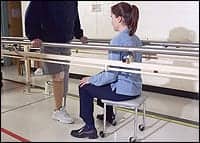 |
In the United States, about one third of people 65 and older fall each year, according to the National Center for Injury Prevention and Control; 20% to 30% of those who fall suffer serious injury such as hip fractures or head traumas, severely affecting quality of life. As is often the case, patients usually consult the physical rehabilitation team after fall and injury have already occurred. Once a history of falling is established, it can be determined if the cause is environmental or if there are more serious underlying health concerns, such as a heart condition or impaired neurological function. Knowing the causes and risk factors helps the occupational or physical therapist (PT) use their best practices in the prevention of falls and fall-related injuries.
In an elderly or physically challenged patient, loss of footing or traction is a common cause of falls. Loss of footing occurs when there is less than total contact between the person’s foot and the ground or floor. Loss of traction occurs when the ground upon which the person is stepping is wet or slippery and their feet fly out from under them. Examples include tripping, especially over uneven surfaces such as sidewalks, curbs, or floors with carpeting or throw rugs. Loss of footing also happens from using household items that were intended for other purposes like climbing on kitchen chairs or balancing on boxes or books to increase height.
A fall may occur because a person’s reflexes have changed. As people age, their reaction time slows down, making it harder to regain balance following a sudden movement or shift of body weight. “For both elderly and physically challenged patients, when they are less active, changes in muscle mass and body fat also can play a role,” says Craig Kruse, PT, director, Midwest Physical Therapy, Schaumburg, Ill. Loss of muscle mass, especially in the legs, reduces strength to the point where someone is often unable to get up from a chair without assistance. “Normal everyday things become harder for them and they have to put more effort into climbing stairs and carrying things,” Kruse says.
Other causes or risk factors for falls may include: having more than one chronic disease (stroke, arthritis, Parkinson’s, neuromuscular disease, urinary incontinence, or postural hypotension); physical limitations such as wearing glasses or having other visual problems; certain medications that cause dizziness, confusion, disorientation, or slowed reflexes; using an assistive device; depression; cognitive impairment, and wearing shoes with thick, soft soles.
Sally Ragsdale is a nurse practitioner at the Fall Prevention Clinic, Harborview Medical Center, Senior Care Clinic, Seattle. Most of the patients who come to this facility have had a fall. “A lot of geriatricians will also send patients in advance of a fall who are having problems,” she says. “I spend an hour starting out with some patient education on what the fall risk factors are, home safety environment, and medication review. I ask them if they’ve had a fall and to describe it very specifically.” Ragsdale will ask if patients were walking when they tripped, were they dizzy, did they have headaches, chest pains, or any complications or injuries, what kind of shoes they were wearing, what the walking surface was like, etc. “I try to piece together what things contributed to that particular fall.” Then she discusses where they live, the number of floors, is there carpeting, night-lights, any kind of assistive devices or aids, are the walkways clear of clutter? “It’s really kind of detailed,” Ragsdale says.
The multifactorial risk assessment starts out with visual acuity with correction if patients are using glasses for distance and arranging an eye examination if needed. They do a “timed up and go” where the person gets up from a chair without using the arms, walks a defined distance, and then turns around and comes back to the chair and sits down. “The risk of falling increases the longer it takes,” she notes. “It gives me a mental picture of how difficult it is for them to walk.” A postural blood pressure check is done along with an evaluation of a patient’s mental status for alertness and orientation. Ragsdale does a full neurological and musculoskeletal examination, checking sensations, extremity strength, peripheral nerves, reflexes, range of motion, gait, balance, and stance, for example.
AN OUNCE OF PREVENTION
Most falls result from a combination of factors. One half to two thirds of falls occur in or around the patient’s home, according to the Centers for Disease Control and Prevention’s “Falls Among Older Adults: Summary of Research Findings.” According to the Fall Prevention Center of Excellence, successful fall prevention in the home and out in the community involves three main strategies of balance training and physical activity, medical management, and environmental/home modifications. “We are trying to get community-based organizations throughout California to do all the things you need to do to reduce falls,” says Maria Henke, a coinvestigator with the Fall Prevention Center of Excellence and communications director of the University of Southern California’s Leonard Davis School of Gerontology and the Ethel Percy Andrus Gerontology Center. “We work with what already exists in the community, sharing expertise in the environment, particularly home and community safety in relation to fall prevention,” she states. The group is also involved in identifying the causes and frequency of fall-related injuries, building coalitions, and creating systems changes to improve the programs and services available to reduce fall risk. Henke has been instrumental in the development of several Web sites promoting healthy aging including ageworks.com, stopfalls.org, and homemods.org.
In addition, through other facilities and partnerships, the Fall Prevention Center of Excellence offers an instructor training program called FallProof; group physical activity classes in the community, which recommend balance and mobility as a strategy for fall risk reduction; as well as conducting research in the area of fall prevention and medical management of risk factors for falls. Staff members are skilled in evaluating and developing fall prevention programs. The Fall Prevention Center of Excellence is headquartered at USC’s Andrus Gerontology Center in Los Angeles.
Tips for the prevention of falls that the therapist will want to communicate to patients include having a thorough physical examination every year, modifying or adjusting medications, and exercising regularly to improve strength, balance, and coordination. “This includes weight-bearing exercises to improve bone density,” adds Sara Hambidge, a PT who works with Sparkspeople.com and Babyfit.com. Gait training can help, too.
Removing or fixing any hazards in the home or living environment is also key in preventing falls. If an inspection is done, health professionals should take note of any clutter, inadequate lighting, exposed electrical wires or cords, throw rugs, cracks in driveways or sidewalks, or wheels on chairs. Consider placing fluorescent tape on the edges of top and bottom steps. According to Hambidge, preventive measures may mean installing handrails in stairwells; installing grab bars and using rubber mats and nonskid strips in the shower/bath and beside toilets; adjusting chairs and beds to heights that are easy to get in and out of; installing bed rails; wearing nonskid shoes; and using step stools with handles. Patients should avoid walking around in socks, stockings, or floppy backless slippers. Proper education of patients on the use of assistive devices such as walkers or canes, hip protectors/pads, and bed alarms. Wearing shoulder bags, fanny packs, or backpacks is also recommended in order to leave a patient hands-free. Portable phones, sound-activated lamps, and a flashlight beside the bed can all be helpful.
LEGISLATION IN ACTION
The Keeping Seniors Safe From Falls Act of 2006 (HR 5608*) was introduced in the House of Representatives on June 14, 2006, by Representatives Ralph Hall (R-Tex) and Frank Pallone, Jr (D-NJ). The bill was referred to the House Committee on Energy and Commerce, and is similar to the Keeping Our Seniors Safe From Falls Act (S 1217), which was passed by the Senate during the 108th Congress.
HR 5608 directs the Secretary of Health and Human Services to expand and intensify programs with respect to research and related activities concerning elder falls. It offers a national approach to reducing falls among older adults, which focuses on the daily life of senior citizens in residential, institutional, and community settings. The bill’s objectives include: developing effective public education strategies in a national initiative to reduce falls among older adults in order to educate older adults, family members, health professionals, caregivers, and others.
Overseeing and supporting demonstration and research projects to be carried out by qualified organizations, institutions, or consortia of qualified organizations and institutions. Intensifying services and conducting research to determine the most effective approaches to preventing and treating falls among older adults.
Evaluating the effect of falls on health care costs, the potential for reducing falls, and effective strategies for reducing health care costs associated with falls. A total of $35 million in annual funding is requested for each fiscal year 2007 through 2010.
*Source: Used with permission from the National Council on Aging, Center of Health Aging, Legislation, Briefing Summary, “Keeping Seniors Safe From Falls Act of 2006.”
Nina Silberstein is a contributing writer for Rehab Management. For more information, contact .



